TAKEAWAY: Some say there is no such thing as a scoop for newspapers in the era of Twitter and social media. The Snowden story shows us differently, especially for Hong Kong’s South China Morning Post
Here is how a scoop moved across platforms
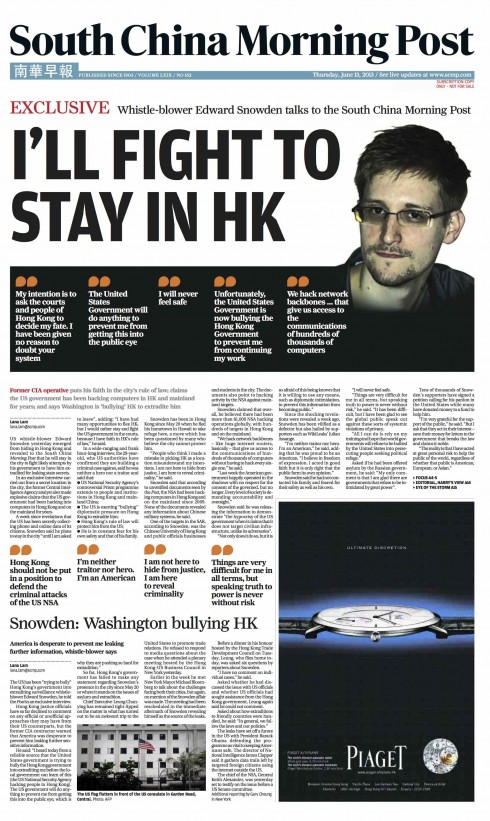

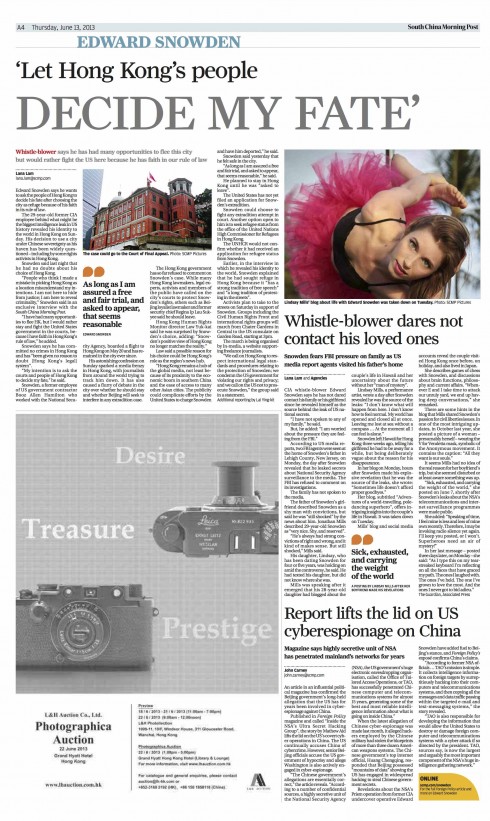
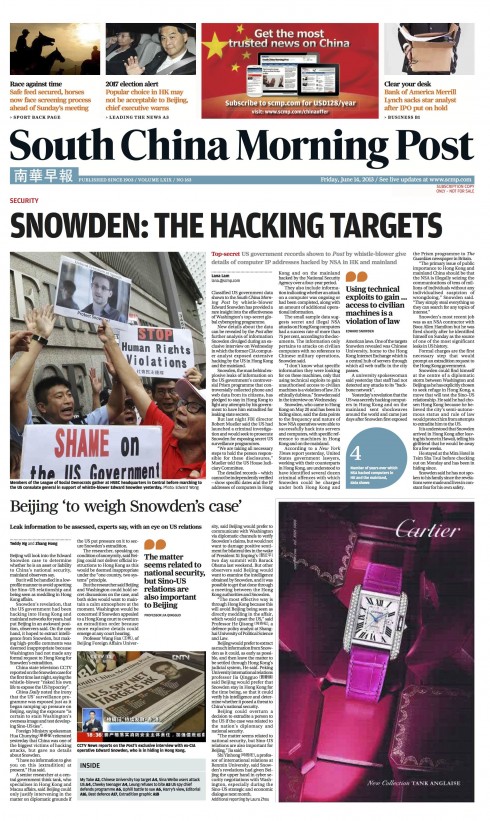

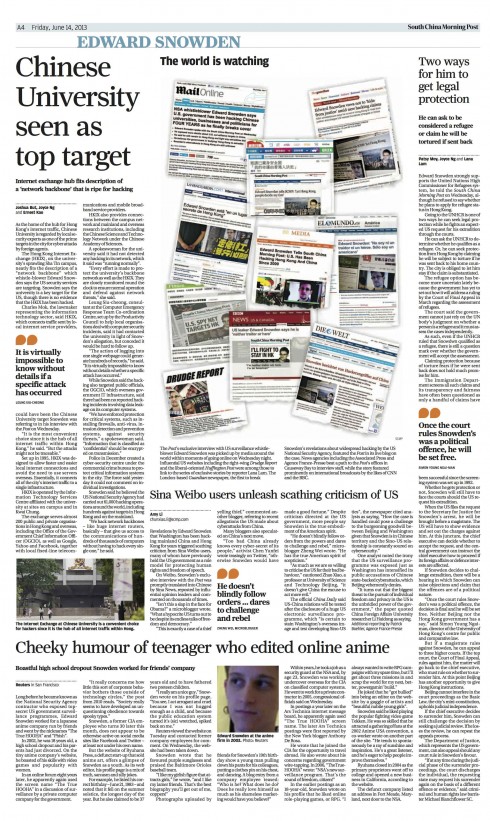
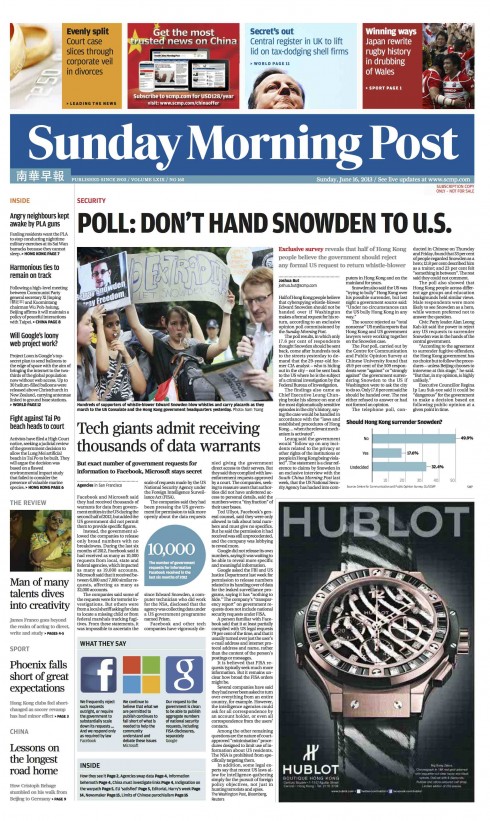

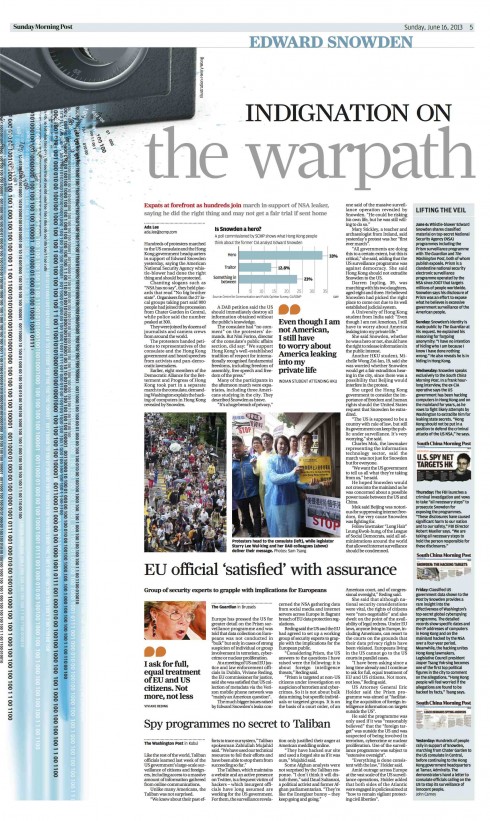
These are the first four days of coverage of the Edward Snowden exclusive story, as handled by the South China Morning Post (pages courtesy of Carl Jones, design director, SCMP)
When Edward Snowden, the 29-year-old American whistleblower behind the NSA surveillance revelations, chose Hong Kong as his destination and base of operations, it put the South China Morning Post on alert, for sure, placing that English-language newspaper with the 110-year history, at the center of one of the biggest stories ever.
As I have been involved with the rethinking of the South China Morning Post recently, I knew that the editors would seize the opportunity and make the best of it, which they did.
In the process, as you will find out in this post today, they have created an example of how scoops are handled in the digital age.
For those who think that exclusives and scoops are difficult—if not impossible—for traditional newspapers in the era of instant news and gratification a la Twitter, the SCMP provides us with proof to the contrary.
I have tried to piece together the story behind the Snowden exclusive interview with my friends in the South China Morning Post newsroom. I thank them for all the wonderful information they have provided me for today’s blog.
Anatomy of a scoop in the digital age.
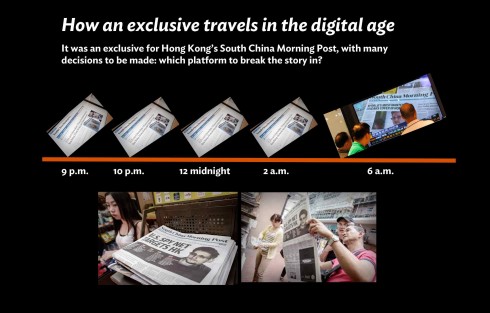
The one question that floats like a giant bubble in every newsroom is “how can we handle a true exclusive scoop in the days of multi platforms”?
If we put it online, say many editors, we give it away to the competition. If we hold it for print, we may risk that someone else gets the story.
What to do?
At the South China Morning Post, the decision was not difficult. I remember having these discussions when we were rethinking the South China Morning Post. It is about the story first, not the platform.
The Snowden interview, that exclusive now quoted globally, first went, in part, online.
Soon, the www.scmp.com website was inundated with people wanting to read the story.
In the words of Wang Xiangwei, editor in chief of South China Morning Post, the paper’s top writers and editors worked to get the first part of the interview online that evening. The reaction, he said, was immediate, with calls and emails coming in soon after from major U.S. networks –- including ABC, CBS and NBC –- to television stations in Russian, India and Mexico.
“Indeed our site has been inundated since the exclusive hit last week. I would say SCMP.com coped well given the huge surge of traffic witnessed within such a short space of time,” says Ben Abbotts, Deputy Director, Digital Business Development.
From online to print: how the Snowden interview exclusive travelled
Here online editor Wang Feng gives us a chronology of how the story developed across platforms:
Our online managing editor Sarah Graham put a “teaser” online first at about 9 p.m, and then started publishing exclusive stories from the interview (altogether 5-6 of them I think) at a pace of about one per hour until about 3am.
“We actually debated on whether to put the exclusive package out early, and a few senior editors on the print side argued against it, saying that local newspapers in Hong Kong, including both the Standard and the Chinese language papers, have deadlines as late as 2 a.m. so they’ll probably pick up our stories and splash on them the next day, competing against us with our own stories in the print market. (which most of them did in the end),” says Wang Feng.
Good sense prevailed, and Editor in chief Xiangwei ultimately decided to go online early for the international impact as the SCMP’s European readers were already in their afternoon and the US readers in their mid morning.
It is noteworthy to see that the entire interview did not go online at once. The editors decided to spread it at intervals of one hour or so, securing that readers will get the story one bit at a time, also a way not to let the cat out of the bag totally for the competition to grab.
The scoop lives in social media
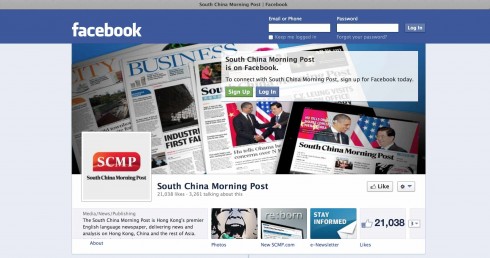
Social media is where a story such as the exclusive Snowden interview is kept alive, and where the editors seek engagement with the readers.
The online team of the SCMP were tweeting “the juiciest bits” of the interview and linking back to each story as they published portions of the exclusive package on Thursday night and Friday morning, according to online editor Wang Feng.
The SCMP also made sure to keep the story alive in Facebook, where one typical question of the day was:
Are you planning to join the Support Snowden march today?
The design perspective
Carl Jones, design director at the South China Morning Post, with whom I worked closely on the redesign, tells me that it was exciting—-and challenging—for him and his graphic team to handle the visual presentation of the story.
It was a truly unique week for this newspaper, possibly the biggest exclusive story we’ve had in decades.There were two editors organizing the coverage; Chow Chung Yan and Niall Fraser. I worked closely with them and we’ve done special front pages and extended our Focus pages for extra coverage. Was a difficult one visually as there were not many visuals to support the immense amount of copy but Henry Wong came to the rescue as usual.
Brand power and scoops
While we don’t know all the details of how the South China Morning Post got the exclusive Snowden interview (we probably will in the near future), we do know that the newspaper was approached with the offer of the interview. It did not require a reporter’s investigative craft to get it.
I agree with The New York Times’ David Carr that getting scoops is not how it used to be.
The way to break a big story used to be simple. Get the biggest outlet you can to take an interest in what you have to say, deliver the goods and then cross your fingers in hopes that they play it large. That’s now over. Whether it’s dodgy video that purports to show a public official smoking crack or a huge advance in the public understanding of how our government watches us, news no longer needs the permission of traditional gatekeepers to break through. Scoops can now come from all corners of the media map and find an audience just by virtue of what they reveal.
However, there is still something to be said for the power of a brand, as in a newspaper brand, that may still be just the bait dangling in front of those ready to tell their exclusive stories.
Apparently, Mr. Snowden knew well about how to pick the brands he would share his big story with. I am sure we have not heard the last from the young whistleblower. And, as long as Hong Kong is his choice of a hideaway, the South China Morning Post may be in for future scoops.
We are tuned in, as I am sure are readers globally. Stay informed with www.scmp.com
The Snowden story and the SCMP
Edward Snowden Interview Brings South China Morning Post ‘Unprecedented’ Attention
http://www.huffingtonpost.com/2013/06/14/edward-snowden-south-china-morning-post_n_3441250.html?utm_hp_ref=media
Quotes from SCMP editor, Wang Xiangwei:
Once this whole thing is over, our reporters and editors will write a postscript article, like the Guardian did
how we got hold of the interview, how it was conducted.”
All about Edward Snowden, the whistleblower
Edward Snowden: the whistleblower behind the NSA surveillance
http://www.guardian.co.uk/world/2013/jun/09/edward-snowden-nsa-whistleblower-surveillance
Highlight:
The 29-year-old source behind the biggest intelligence leak in the NSA’s history explains his motives, his uncertain future and why he never intended on hiding in the shadows
Our previous South China Morning Post blog posts:
https://garciamedia.com/blog/articles/south_china_morning_post_new_beginnings_in_a_new_hong_kong_new_china
https://garciamedia.com/blog/articles/on_the_fourth_day_south_china_morning_post_design_evolves
https://garciamedia.com/blog/articles/south_china_morning_post_three_months_after_its_rethinking
https://garciamedia.com/blog/articles/in_hong_kong_a_new_website_design_for_south_china_morning_post/
Of special interest today
Monday Q&A: Designer David Wright, departing NPR for Twitter, has just one favor to ask
Monday Q&A: Designer David Wright, departing NPR for Twitter, has just one favor to ask
I thank friend J Ford Huffman for sharing this one with me. We both appreciate David Wright’s final quote in this interesting interview. When asked the question:
So, let’s say you’re leaving NPR and the whole news world throws you a party. And they say, What’s the one thing we can do for you while you’re gone? What would you want them to do?
Wright answered:
Oh! This is easy. My one wish is for every news org, to really understand the importance of having — it doesn’t have to be a visual designer, but to have design thinkers have a seat at the table. It’s not about deciding what work gets done or how it gets done but it’s really about making design as important an ingredient in what we make as editorial, as reporters, writers, photographers, and technologists. Designers bring such a unique value to the table and can just help solve so many interesting problems in really thoughtful ways. The best presents the news community could give me is to say, Everybody, designers are always at the table.